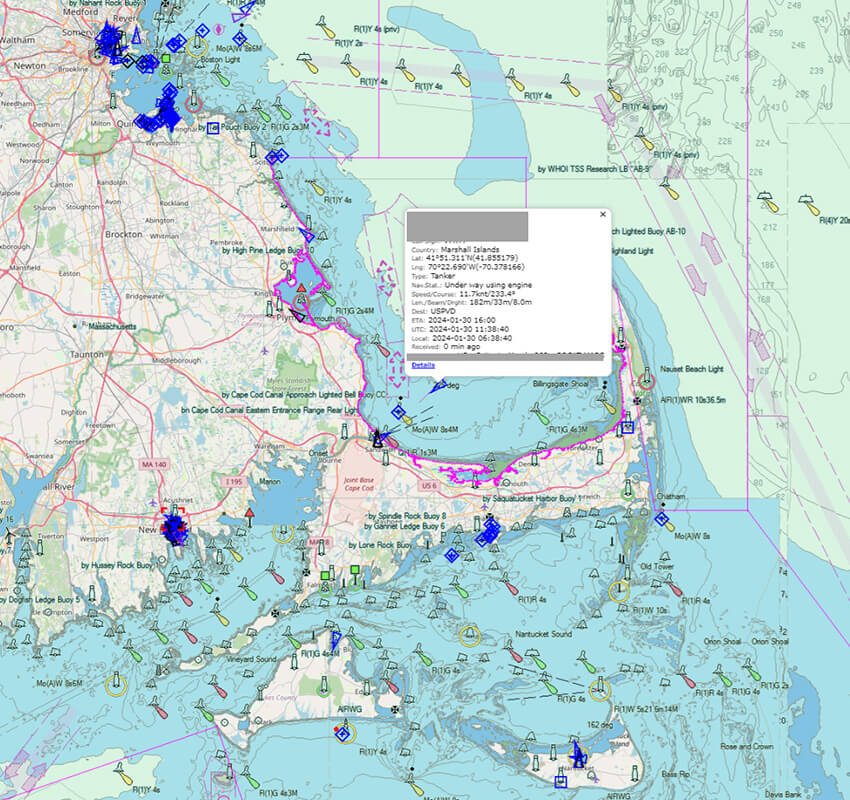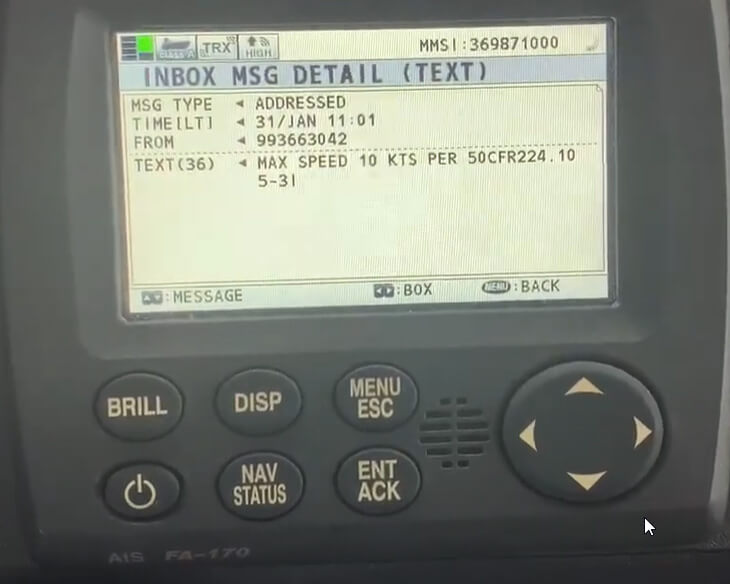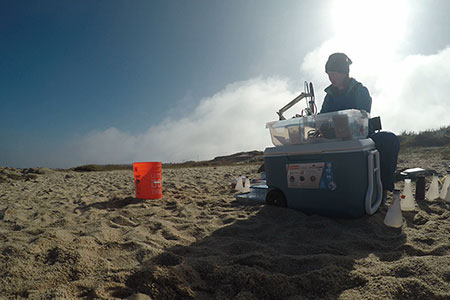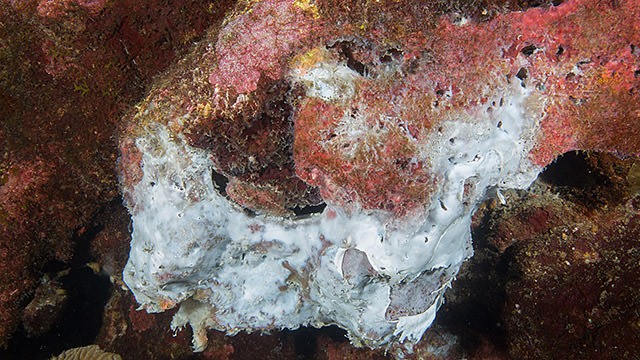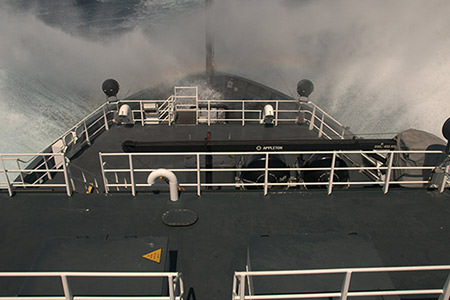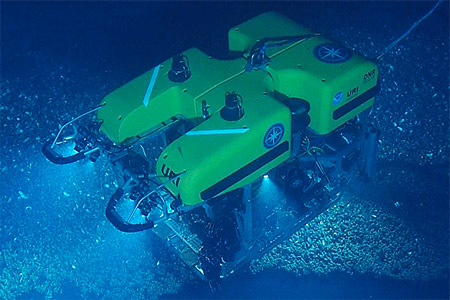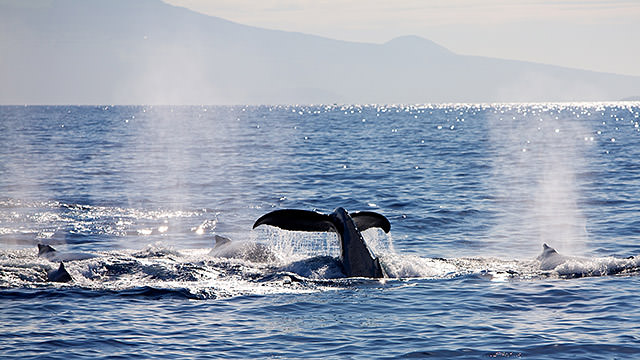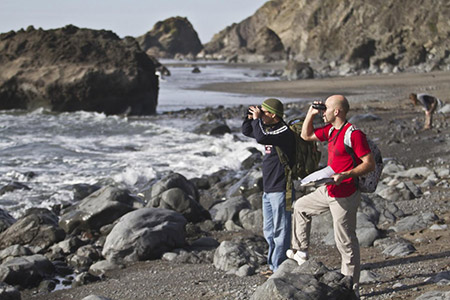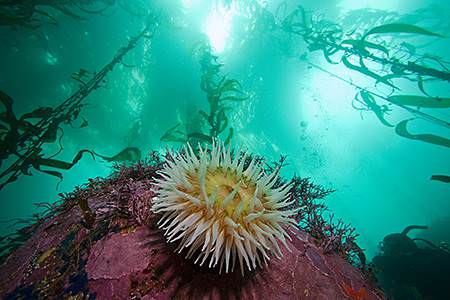We have been busy across the National Marine Sanctuary System! Join us behind the scenes for a look at research taking place above and below the water. Learn fun facts about scientific instruments and techniques, get updates on long-term monitoring projects, and meet some of our staff, partners, and volunteers who make it all happen! Be sure to check back each week for the latest field notes.
Scientists Study Whale Baleen to Monitor Synthetic "Forever Chemicals" in Ocean
July 17, 2024
Baleen whales use a filter-feeding system of fringed plates made from keratin, called "baleen," hanging from the roof of the mouth that strains the seawater for food. Not only does this baleen collect food particles, but researchers have found the baleen also accumulates synthetic chemical substances like per- and polyfluoroalkyl substances (PFAS), providing a possible way to monitor the chemicals in the ocean.

PFAS are used in thousands of commercial and industrial products, including aqueous fire-fighting foam, disposable food packaging, furniture, cookware, cleansers, and others. These chemicals flow into the ocean from various point and nonpoint sources of pollution. In high concentrations, PFAS can have adverse effects on the growth and photosynthesis of phytoplankton and toxic effects on zooplankton. These chemicals also accumulate in the food chain, having been found in the tissues of marine plants and animals, including fish that humans eat.
Called "forever chemicals" because they break down so slowly, PFAS are a growing environmental and health concern. Tracking them in ocean ecosystems has so far been difficult. Reliable methods for monitoring PFAS in the ocean are needed. Researchers from Stellwagen Bank National Marine Sanctuary, U.S. Environmental Protection Agency, University of Rhode Island, College of the Atlantic, Stanford University, Center for Coastal Studies, and International Fund for Animal Welfare have found that measuring PFAS in whale baleen proves to be a reliable method for monitoring them in the marine environment.

In the study, researchers sampled baleen from 17 individual whales from the Atlantic and Pacific coasts of North America, representing six different species. They found quantifiable levels of common PFAS in all 220 baleen samples tested. While PFAS have been found in other keratin-based tissues, including bird feathers and human hair, this is the first report of these contaminants in baleen. The study also revealed that these chemicals are possibly being transferred from mothers to calves.
Researchers compared PFAS levels found in five different tissue types from whales, and found that skin and blubber were the least effective tissues for PFAS monitoring. However, due to global and U.S. laws, skin and blubber are the only types of tissue that can be collected from live cetaceans. In this particular study, large tissue samples were collected during necropsy exams from deceased whales. This was a proof of concept study that shows detection of PFAS from baleen is possible. As this research progresses, much smaller baleen tissue samples could be collected from live whales, which would make baleen a reliable and potentially minimally invasive way to monitor PFAS in the ocean.
Shipwreck Discovered in Florida Keys National Marine Sanctuary: Star of the Sea foundered in 1911
July 2, 2024
A new shipwreck has been identified in Florida Keys National Marine Sanctuary, thanks to the help of 18 instructors and advocates from the nonprofit organization Diving With a Purpose, who joined NOAA researchers to document the site at French Reef off of Key Largo.
The four-masted Star of the Sea was carrying lumber from Pensacola, Florida when it grounded at French Reef in the Florida Keys in October 1911. Using historical records, sanctuary researchers identified the names of almost a dozen ships that wrecked on French Reef in the 19th and 20th centuries, corresponding with the general time frame of artifacts found there. Detailed recording by the Diving With a Purpose team revealed several artifacts, including the remains of rigging and a steam boiler, which most closely matched what would be found on a large schooner. The only vessel of this kind lost at French Reef was Star of the Sea, which was built in Bath, Maine in 1887, and was originally named Katie J. Barrett.
"The wreck is largely unknown to the current Keys community," said Sanctuary Maritime Archaeologist Matthew Lawrence. "It's not in a spot where most people dive, snorkel, or fish, even though it is easily accessible. It's great to bring an unknown story back to life, with a touchstone like a shipwreck to give it physical presence."
Divers working the wreck came to the Florida Keys from as far away as South Africa for the week-long activity, which began with extensive land-based training. The Diving With a Purpose team was half composed of instructors or instructors in training who had experience in underwater mapping, while the other half had never done this kind of work before. Divers were divided into teams assigned to a specific section of the shipwreck, making dozens of sketches and hundreds of measurements that will soon produce a detailed, site map drawing (stay tuned to the Florida Keys shipwrecks page).
The wreck site, scattered across 250 feet in 20 feet of water, has also been digitized into a 3D model from more than 2,500 individual images. The shipwreck is one of more than 800 historical sites located within sanctuary waters. It is nicknamed the "Cable Wreck" due to the snarled pile of wire rope rigging at the site.

Diving With a Purpose is a long-time partner of the National Marine Sanctuary System. Congratulations and thank you to the team that worked on the mapping project for Star of the Sea!
One of the goals of the National Marine Sanctuary System is to provide opportunities for people to learn about our nation's maritime heritage through experiencing it themselves. Historical sites within Florida Keys National Marine Sanctuary are open to diving and snorkeling. Please help conserve our maritime heritage and do not damage or remove historical resources. If you discover a historical resource within Florida Keys National Marine Sanctuary, do not disturb it. Instead, make note of where you found it and then provide this information to sanctuary staff. Be a good steward; take only pictures and leave only bubbles. Learn more about responsible diving practices here.
Tissue Samples Show Coral Disease at Flower Garden Banks is Not Stony Coral Tissue Loss Disease
June 24, 2024
During a monitoring cruise from August 30-September 2, 2022, Flower Garden Banks National Marine Sanctuary and National Coral Reef Monitoring Program divers observed a coral disease outbreak at East and West Flower Garden Banks. Initial analysis showed that symptoms were similar to the dreaded Stony Coral Tissue Loss Disease (SCTLD) affecting reefs in Florida Keys National Marine Sanctuary, including lesions and tissue loss.
Over the following months, divers enacted an emergency action plan to treat corals with antibiotics, photograph impacted corals, document their locations, and collect samples and other data. Coral disease experts then began reviewing this information to either confirm or rule out the presence of SCTLD and guide the next steps.

Many coral diseases can be similar in appearance, which makes diagnosis difficult. So, scientists have been hard at work trying to develop a case definition for SCTLD, which would clearly identify specific characteristics of the disease and how it can be diagnosed. This means looking beyond the outward characteristics of diseased corals and examining the histology, a microscopic study of the coral tissues.
Thanks to all of this hard work, we can now say that the disease outbreak at East and West Flower Garden Banks was not SCTLD. The tissue samples from the diseased Flower Garden Banks National Marine Sanctuary corals did not match the case definition. The assumption now is that the 2022 disease outbreak was a form of white plague disease. As yet, there is no case definition for white plague disease, but there is hope that this can be developed using previously preserved samples from past outbreaks of the disease.

The Good News: White plague disease is not as lethal or as quick-spreading as SCTLD.
The Bad News: Any disease outbreak is a sign that things aren't what they should be on the reef.
More About Coral Diseases
With names like white plague, white pox, black band, dark spot, and yellow band, it's clear that coral diseases are named for their appearances—but, what else do we know about them? NOAA's Coral Disease Health Consortium website goes into the details.
Sanctuary Installs New Data Buoy in Lake Michigan
May 23, 2024

A team from Wisconsin Shipwreck Coast National Marine Sanctuary, NOAA Great Lakes Environmental Research Laboratory, and University of Wisconsin-Milwaukee's School of Freshwater Sciences, recently deployed a new data buoy in the sanctuary. The buoy was engineered and built by UW-Milwaukee and funded through a grant from the Fund for Lake Michigan.
The buoy provides real time wind, wave, current, water temperature, and water quality data to the public and researchers, which fills a large gap in data collected along the western Lake Michigan shoreline and improves public safety on the water.
The buoy is located in 120 feet of water with the water temperature sensors located at every 10 feet, which is particularly appreciated by the charter and recreational fishing communities. Along with three Sofar Ocean "smart moorings" maintained by sanctuary staff, there are now four real time data buoys in the region.
Channel Islands Divers Support Research on Acoustics, Giant Kelp, and Bioplastics
May 21, 2024

NOAA divers spent the day at San Miguel Island in Channel Islands National Marine Sanctuary finishing up the West Coast observations by swapping out the acoustic receivers that are located at 13 sites around the Channel Islands. With acoustic receivers, we can get the exact position of tagged animals that use the sanctuary as habitat and improve our understanding of animal movement and connectivity between the sanctuary and mainland. Signals from white sharks, giant sea bass, and other large tagged sharks and fish are recorded when they swim within a half mile of an acoustic receiver.
The dive team also supported the research of a current Dr. Nancy Foster Scholar, Natalie Dornan, who is studying the cycling of nutrients in kelp forest ecosystems, by diving inside and outside of kelp forests to collect water and kelp samples. Dornan's dissertation work aims to improve our understanding of how nitrogen drives kelp production, contributing to our ability to manage kelp forests in the West Coast Region effectively in the face of a changing climate.
Another project supported through this field work was a National Science Foundation-funded bioplastics (biodegradable materials) project that needs to be visited underwater at least twice a year to remove the algae growth on the sampling gear.
Over 1,000 Volunteers Help Sanctuary Count Koholā
May 14, 2024

During the 2024 Sanctuary Ocean Count, volunteers went to their designated sites on the islands of O‘ahu, Kaua‘i, Molokaʻi and Hawai‘i to count koholā (humpback whales) and record any other species seen. At the same time, Pacific Whale Foundation Great Whale Count volunteers collected data from Maui and Lānaʻi, marking the sixth year that both counts were coordinated on the same days, ensuring the data from all the main Hawaiian Islands were collected simultaneously. The counts took place from 8:00 a.m. to 12:15 p.m. on the last Saturday of January, February, and March.
As the 2024 koholā season concludes in Hawaiʻi with the koholā migrating back to their summer feeding grounds, here is a recap. This year, more than 1,300 volunteers participated and observed 5,120 koholā during the counts. Due to the nature of how this data is collected, the total number may represent duplicate sightings of the same koholā by different observers or at different time periods or locations throughout the count days. Volunteers were also able to educate 1,110 members of the public who stopped by their sites to learn more information about koholā and the counts.
"While the total count numbers are intriguing, what truly matters is observing the trends over time," said Sanctuary Ocean Count Coordinator Cindy ʻIwalani Among-Serrao. Data collected during the Sanctuary Ocean Count and Great Whale Count, combined with other research efforts, can help reveal trends in koholā occurrence within and among whale seasons.
"We want to mahalo all our volunteers who participated this season and we look forward to welcoming back the koholā for the 2025 season," Among-Serrao concludes.
Ocean Count is supported by the National Marine Sanctuary Foundation. For more information, contact Cindy.Among-Serrao@noaa.gov.
Oldest Recorded Rhodoliths Discovered in Flower Garden Banks National Marine Sanctuary
April 23, 2024
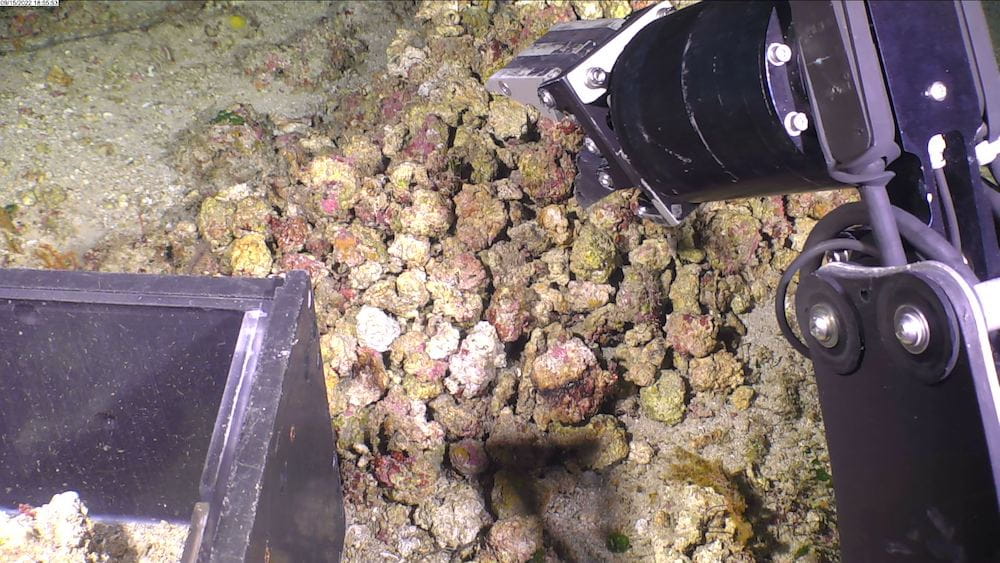
Oldest recorded what? Rhodoliths.They're colorful calcareous nodules of coralline red algae that form around marine rubble (e.g., shells, corals, and rocks), and they are important for structure and three-dimensional habitat in marine environments. Other organisms like corals, clams, scallops, and algae attach to rhodoliths, and they provide refuge for the early growth stages of commercially important fishes.
Sarah Olmstead, a master's thesis student at The University of Alabama has discovered what appear to be the oldest documented rhodoliths to date, and they were found at East Flower Garden Bank and Elvers Bank at mesophotic depths (about 130 to 490 feet) in Flower Garden Banks National Marine Sanctuary, located in the northwestern Gulf of Mexico. The oldest rhodoliths found in this study were from Elvers Bank, and were found to have nucleation points that formed roughly 9,500 to 14,800 years before present. That means some of these ancient rhodoliths date back to the end of the Pleistocene, living through the Holocene deglaciation period and sea-level stabilization.
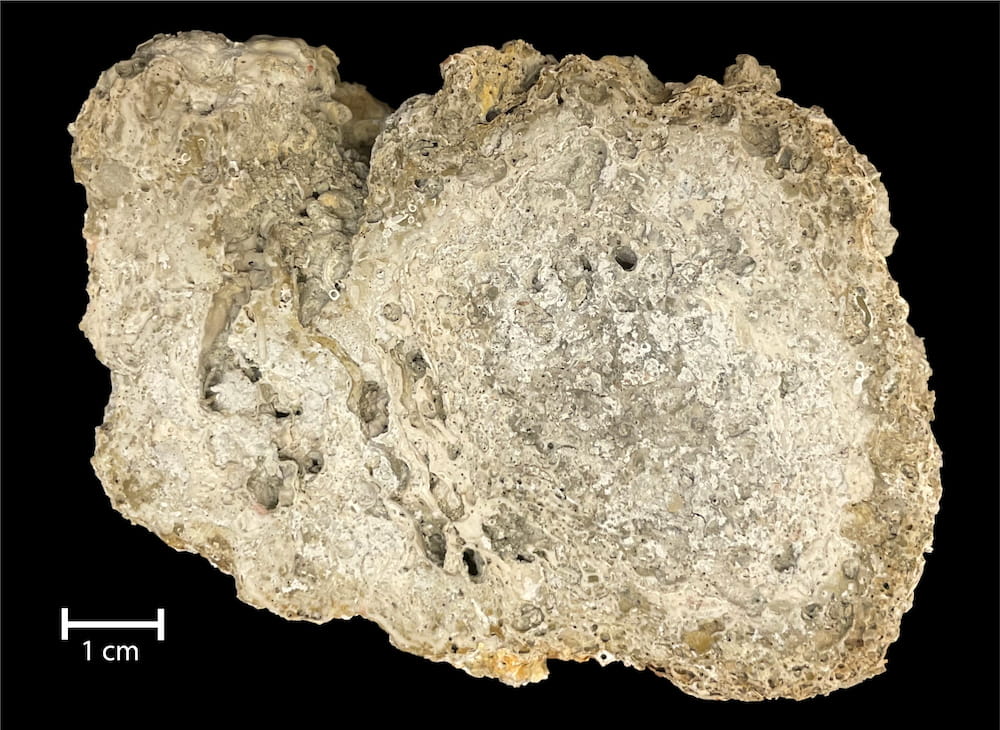
In addition to the old age of these rhodoliths, the study also shows that they grew slowly and took so long to get to their current sizes, that any major ecological damage to the area would make it impossible for them to recover within human timescales. Olmstead's findings drive home the importance of protecting such habitats from possible human harm. While these rhodoliths are found within protected parts of the national marine sanctuary, there are still many rhodolith beds that exist outside of current sanctuary boundaries.
ACCESS: 20 Years of Monitoring!
March 4, 2024
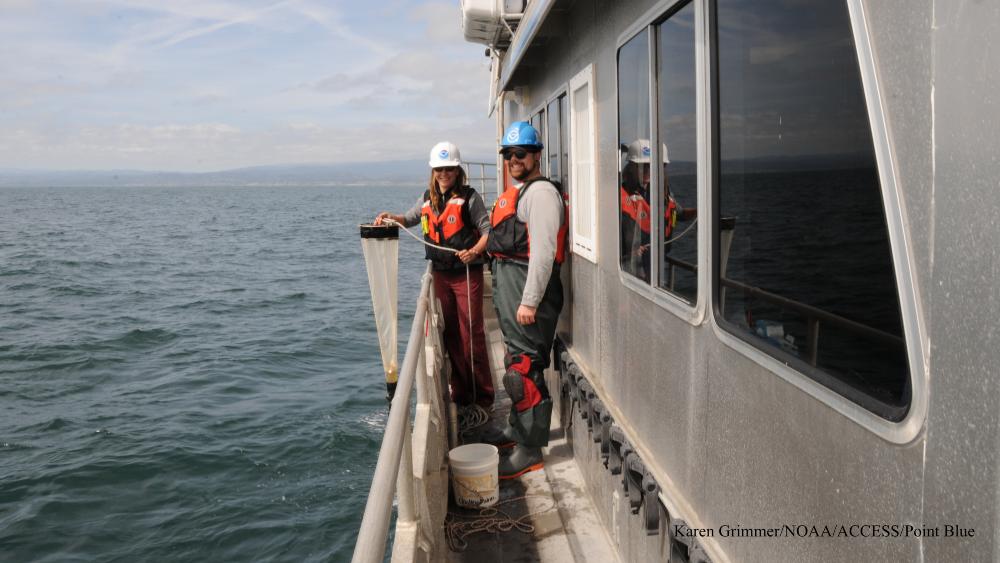
Without good data, we simply wouldn’t know enough about the ocean to help save it. Just like humans go to the doctor for an annual check-up, scientists take routine measurements and observations to assess the health and condition of the ocean. The Applied California Current Ecosystem Studies (ACCESS) is an at-sea monitoring program with 20 years of data collection within Greater Farallones, Cordell Bank, and Monterey Bay national marine sanctuaries carried out in partnership with Point Blue Conservation Science. ACCESS data helps resource managers, policy makers, and conservation partners improve conditions for ocean wildlife.
Real-Time Notifications Help Right Whales
February 26, 2024
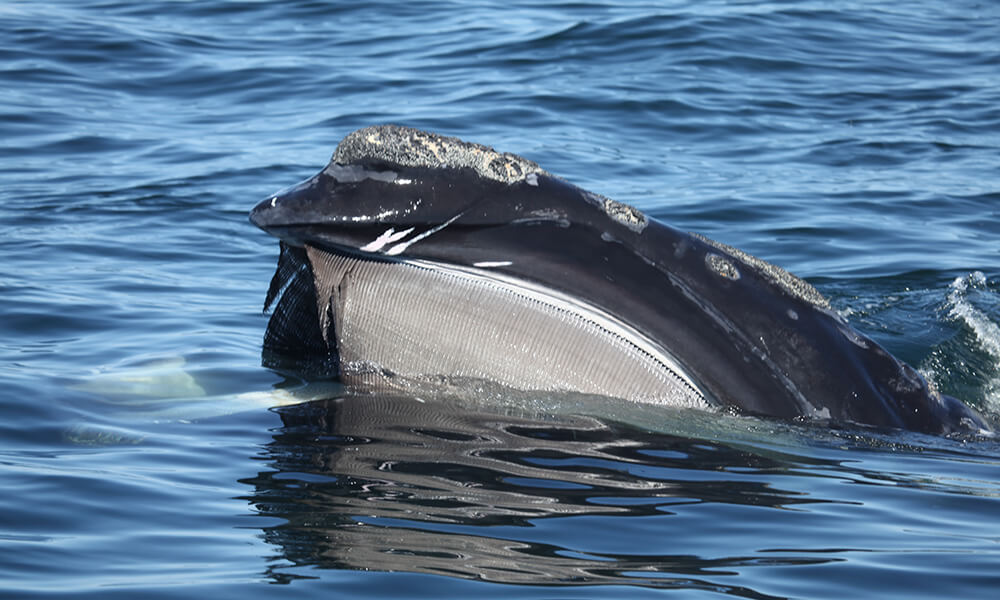
On January 30, 2024, staff at Stellwagen Bank National Marine Sanctuary and Maritime Information Systems, Inc. in cooperation with the U.S. Coast Guard successfully transmitted a text message using the Automated Identification System (AIS) directly to the bridge of a large tanker ship notifying the vessel that it exceeded the speed limit within the Cape Cod Bay NOAA Right Whale Seasonal Management Area. Most vessels 65 feet or longer must travel at 10 knots or less in certain locations (called seasonal management areas) along the U.S. East Coast at certain times of the year. This mandatory regulation reduces the likelihood of deaths and serious injuries to endangered North Atlantic right whales that result from collisions with vessels.
The short text message ("MAX SPEED 10 KNOTS PER 50CFR224.105-31") was displayed on the screen of the AIS receiver and charting system display of the vessel. The team received an acknowledgement message from the vessel, certifying that the speed limit message was successfully received by someone aboard the vessel. This feature is also planned to be used to transmit near-real time North Atlantic right whale sighting data and/or NARW management rules displayed on Whale Alert to vessels with AIS capability, and eventually could be utilized more broadly along the East Coast.
This effort, combined with Stellwagen Bank National Marine Sanctuary's North Atlantic Right Whale Corporate Responsibility Program, provides a valuable feedback loop to mariners, resulting in the highest compliance rates in the country for seasonal management areas.
First Water Sampling Event of the Year
February 20, 2024
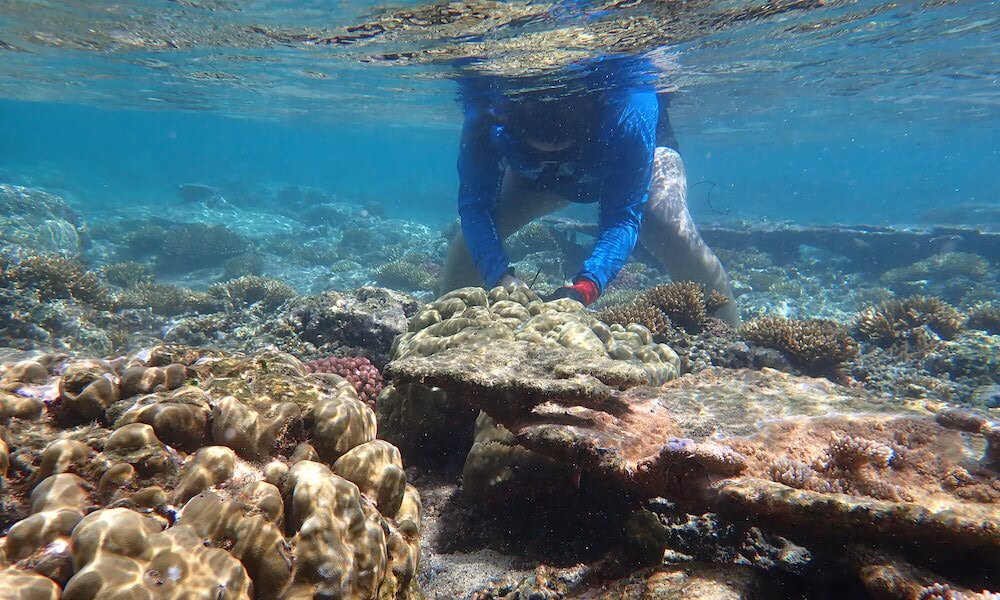
Earlier this year, the first 2024 water sampling event took place at National Marine Sanctuary of American Samoa! One of the 19 NOAA Ocean Acidification Program buoys located around the world is stationed within the American Samoa sanctuary's waters. "Ocean acidification" refers to a change in chemistry of the planet's ocean caused by the uptake of extra carbon dioxide from the atmosphere as a result of humans burning fossil fuels. This chemical change makes it hard for marine life to grow their shells and skeletons. The buoy at Fagatele Bay takes measurements of the carbon dioxide in the water and atmosphere daily. To check if the buoy is taking accurate measurements, researchers periodically collect water samples and send them to a lab in Florida for comparison.
Listening to Boat Traffic and Fish Spawning
February 9, 2024
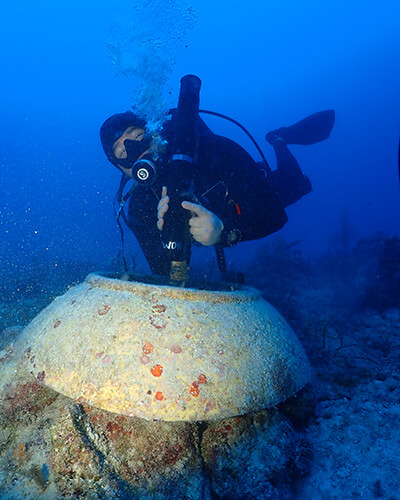
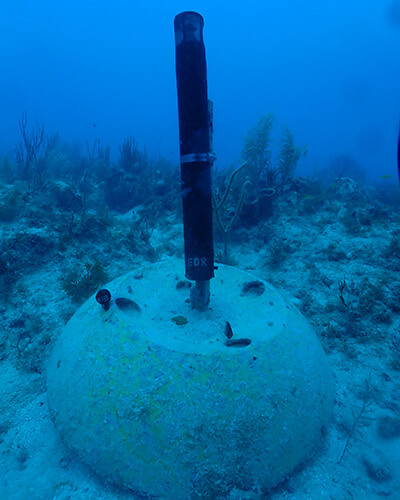
We're listening! Strategically-placed underwater sound recording devices (hydrophones) can tell us a lot about the marine environment. Our Key West-based Mission: Iconic Reefs team in Florida Keys National Marine Sanctuary recently swapped out new devices at Eastern and Western Dry Rocks. The Eastern Dry Rocks hydrophone is listening for boat traffic to help us understand human impact on the reef, while the Western Dry Rocks device is listening for spawning snapper and grouper, as part of the Florida Fish and Wildlife Conservation Commission's annual closure of the area. You can learn more about sound monitoring across the National Marine Sanctuary System on our SanctSound project page.
Archive
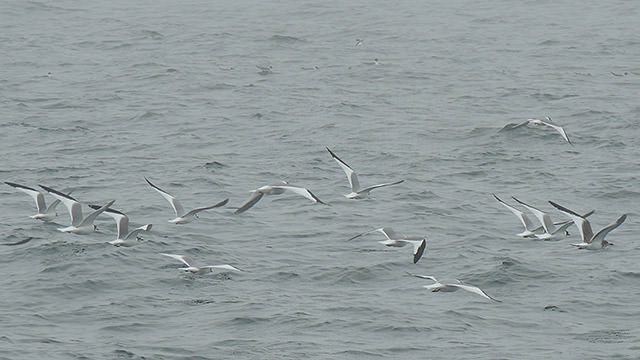
Birdwatching in Olympic Coast National Marine Sanctuary
On Saturday, Aug 13, 2016, our birdwatching group from Olympic Peninsula Audubon Society traveled through the northern waters of the Olympic Coast National Marine Sanctuary on the M/V Windsong out of Neah Bay. Our route traveled through the western entrance of the Strait of Juan de Fuca to Swiftsure Bank, then south over the Juan de Fuca Canyon and back inshore by Tatoosh Island.
Understanding Sanctuary Soundscapes: A Q&A with Carol Bernthal and Sarah Fangman
Marine organisms from tiny fish to enormous whales rely on sound and hearing for their survival, but increasing human activity within our ocean over the last century has also meant increasing levels of noise. Gray's Reef National Marine Sanctuary superintendent Sarah Fangman and Olympic Coast National Marine Sanctuary superintendent Carol Bernthal discuss how understanding the soundscapes within their protected areas can help sanctuary managers better safeguard species that rely on sound.
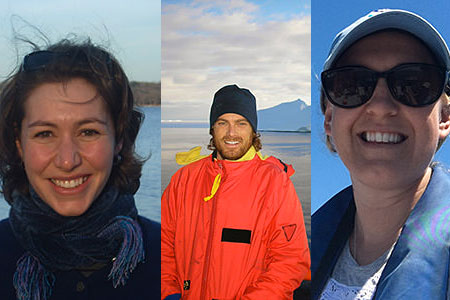
Understanding Ocean Noise Reddit "Ask Us Anything"
Join NOAA scientists Dr. Leila Hatch, Dr. Jason Gedamke and Dr. Jenni Stanley on December 8th for a Reddit "Ask Us Anything" about understanding ocean noise.
The Biology Bus: A Q&A with Nancy Foster Scholarship Alumna Dr. Nyssa Silbiger
Former Nancy Foster Scholar Dr. Nyssa Silbiger and her colleagues Piper Wallingford and Savannah Todd have spent the summer researching intertidal organisms in West Coast national marine sanctuaries -- all out of a camper van.
NOAA scientists report mass die-off of invertebrates at East Flower Garden Bank in Gulf of Mexico
Sport divers on the M/V Fling, diving in the Gulf of Mexico 100 miles offshore of Texas and Louisiana, were stunned to find green, hazy water, huge patches of ugly white mats coating corals and sponges, and dead animals littering the bottom on the East Flower Garden Bank, a reef normally filled with color and marine life. The reef, which is part of Flower Garden Banks National Marine Sanctuary, is considered one of the healthiest anywhere in the region.
Sentinel Sites in Action
Ocean Ecosystem Health in North-central CA
For 13 years, Greater Farallones National Marine Sanctuary (GFNMS) and Cordell Bank National Marine Sanctuary (CBNMS) scientists have collaborated with Point Blue Conservation Science to collect data on the ocean ecosystem. The project, Applied California Current Ecosystem Studies (ACCESS), examines how ocean conditions influence the tiny plants and animals at the base of the ocean food chain which in turn drive the abundance and distribution of top level predators like seabirds and marine mammals. ACCESS data from 13 years of sampling reveal a dynamic ocean influenced by both large scale phenomenon like El Niño, and local conditions such as strong winds that bring cold, nutrient rich water to the surface through “upwelling”.
2016 Nautilus Expedition
This summer, NOAA's Office of National Marine Sanctuaries is teaming up with the Ocean Exploration Trust to explore the marine ecosystems of the West Coast. Working aboard the E/V Nautilus and utilizing remotely operated vehicles (ROVs), scientists will map and explore targets throughout the U.S. West Coast, from Canada to southern California, including five national marine sanctuaries.
A Noisy Ocean: A Q&A with Dr. Leila Hatch
If you're a marine animal, odds are good that you need sound. From whales to small invertebrates like shrimp, many marine organisms rely on sound and hearing for their survival. Sound is the most efficient means of communications over distance underwater, and is the primary way that many marine species gather and understand information about their environment.
Seabirds as Sentinel Indicators of Ecosystem Health
The government alone cannot sustain healthy oceans. It takes stewardship and community involvement in order to combat today’s pressures on our marine ecosystems. The Greater Farallones National Marine Sanctuary uses seabirds as sentinel indicators of the health of our coastal ecosystem, through long-term monitoring of live and dead seabirds.
The State of Monterey Bay: An Interview with Dr. Jennifer Brown
In January, Monterey Bay National Marine Sanctuary released an update to its Condition Report, a detailed assessment of how the sanctuary is doing. In this Q&A, Dr. Jennifer Brown, ecosystem scientist for the Sanctuary Integrated Monitoring Network (SIMoN), explains the importance of this report and what it has to say about the sanctuary.










